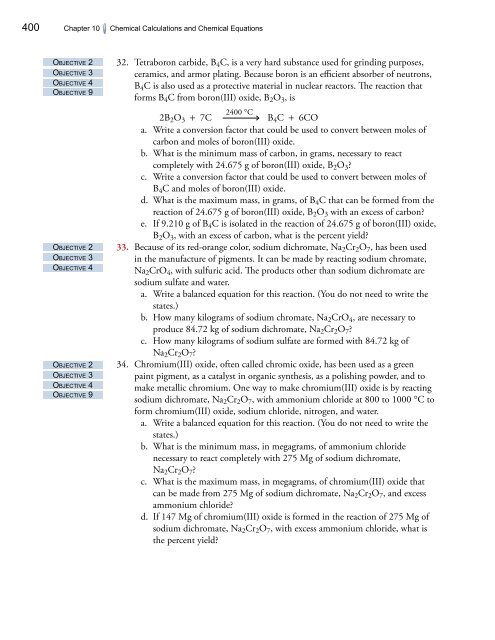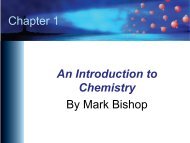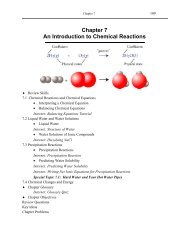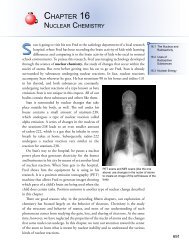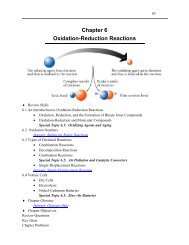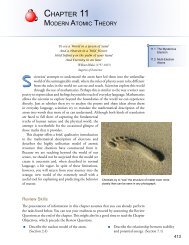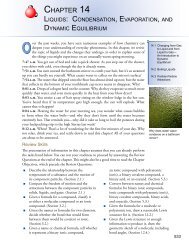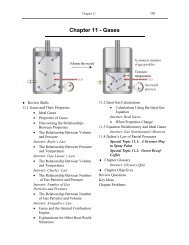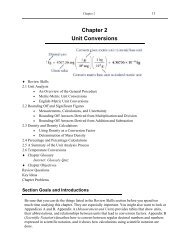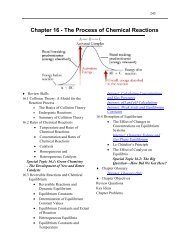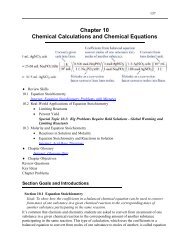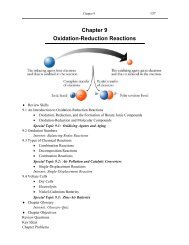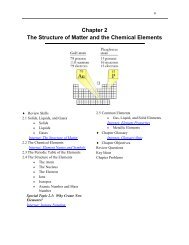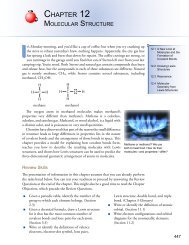Chapter 10 - An Introduction to Chemistry: Chemical Calculations ...
Chapter 10 - An Introduction to Chemistry: Chemical Calculations ...
Chapter 10 - An Introduction to Chemistry: Chemical Calculations ...
Create successful ePaper yourself
Turn your PDF publications into a flip-book with our unique Google optimized e-Paper software.
400 <strong>Chapter</strong> <strong>10</strong> <strong>Chemical</strong> <strong>Calculations</strong> and <strong>Chemical</strong> Equations<br />
Objective 2<br />
Objective 3<br />
Objective 4<br />
Objective 9<br />
Objective 2<br />
Objective 3<br />
Objective 4<br />
Objective 2<br />
Objective 3<br />
Objective 4<br />
Objective 9<br />
32. Tetraboron carbide, B 4 C, is a very hard substance used for grinding purposes,<br />
ceramics, and armor plating. Because boron is an efficient absorber of neutrons,<br />
B 4 C is also used as a protective material in nuclear reac<strong>to</strong>rs. The reaction that<br />
forms B 4 C from boron(III) oxide, B 2 O 3 , is<br />
2400 °C<br />
2B 2 O 3 + 7C<br />
B 4 C + 6CO<br />
a. Write a conversion fac<strong>to</strong>r that could be used <strong>to</strong> convert between moles of<br />
carbon and moles of boron(III) oxide.<br />
b. What is the minimum mass of carbon, in grams, necessary <strong>to</strong> react<br />
completely with 24.675 g of boron(III) oxide, B 2 O 3 ?<br />
c. Write a conversion fac<strong>to</strong>r that could be used <strong>to</strong> convert between moles of<br />
B 4 C and moles of boron(III) oxide.<br />
d. What is the maximum mass, in grams, of B 4 C that can be formed from the<br />
reaction of 24.675 g of boron(III) oxide, B 2 O 3 with an excess of carbon?<br />
e. If 9.2<strong>10</strong> g of B 4 C is isolated in the reaction of 24.675 g of boron(III) oxide,<br />
B 2 O 3 , with an excess of carbon, what is the percent yield?<br />
33. Because of its red-orange color, sodium dichromate, Na 2 Cr 2 O 7 , has been used<br />
in the manufacture of pigments. It can be made by reacting sodium chromate,<br />
Na 2 CrO 4 , with sulfuric acid. The products other than sodium dichromate are<br />
sodium sulfate and water.<br />
a. Write a balanced equation for this reaction. (You do not need <strong>to</strong> write the<br />
states.)<br />
b. How many kilograms of sodium chromate, Na 2 CrO 4 , are necessary <strong>to</strong><br />
produce 84.72 kg of sodium dichromate, Na 2 Cr 2 O 7 ?<br />
c. How many kilograms of sodium sulfate are formed with 84.72 kg of<br />
Na 2 Cr 2 O 7 ?<br />
34. Chromium(III) oxide, often called chromic oxide, has been used as a green<br />
paint pigment, as a catalyst in organic synthesis, as a polishing powder, and <strong>to</strong><br />
make metallic chromium. One way <strong>to</strong> make chromium(III) oxide is by reacting<br />
sodium dichromate, Na 2 Cr 2 O 7 , with ammonium chloride at 800 <strong>to</strong> <strong>10</strong>00 °C <strong>to</strong><br />
form chromium(III) oxide, sodium chloride, nitrogen, and water.<br />
a. Write a balanced equation for this reaction. (You do not need <strong>to</strong> write the<br />
states.)<br />
b. What is the minimum mass, in megagrams, of ammonium chloride<br />
necessary <strong>to</strong> react completely with 275 Mg of sodium dichromate,<br />
Na 2 Cr 2 O 7 ?<br />
c. What is the maximum mass, in megagrams, of chromium(III) oxide that<br />
can be made from 275 Mg of sodium dichromate, Na 2 Cr 2 O 7 , and excess<br />
ammonium chloride?<br />
d. If 147 Mg of chromium(III) oxide is formed in the reaction of 275 Mg of<br />
sodium dichromate, Na 2 Cr 2 O 7 , with excess ammonium chloride, what is<br />
the percent yield?


